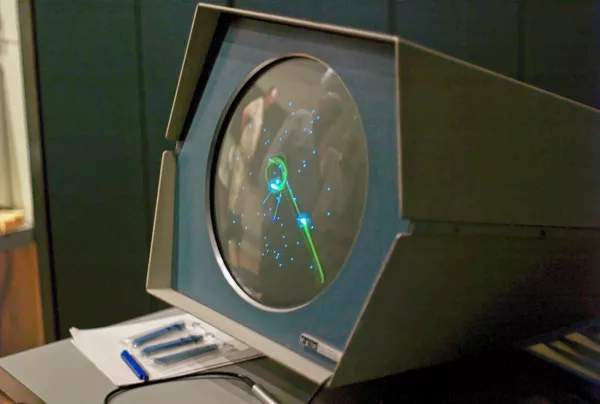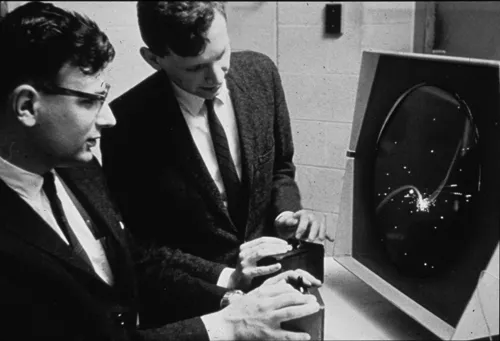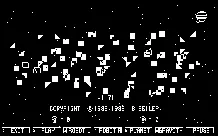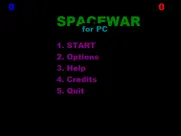Spacewar!
-
 Spacewar!
(2021 on
TRS-80 CoCo)
Spacewar!
(2021 on
TRS-80 CoCo)
Description
Spacewar! is a two player shooter where both players engage in a dog fight with space ships (called The Needle and The Wedge respectively). At the centre of the screen there is a star which pulls the ships constantly towards it. The space ships have limited fuel with which to manoeuvre, and a limited number of torpedoes which are used to destroy the opponent. The ships follow Newtonian physics and can use tactics such as a gravity assist. Players can also activate hyperspace which teleports the ship to a random other location, but with an ever increasing chance of self-destruction.
The game was initially controlled with switches, but a gamepad was later developed to make the game easier to play.
In initial versions the background stars were randomly generated. In later versions the game incorporated the Expensive Planetarium program which was based on real star charts.
Groups +
Promos
Credits (Mainframe version)
5 People
| Programmed by | |
| Additional programming by | |
| Collaborators |
Reviews
Players
Average score: 2.4 out of 5 (based on 3 ratings with 1 reviews)
The first true computer game; evergreen
The Good
I'm currently on a journey of reading about and, wherever possible, playing through the early history of computer games. Spacewar! is the earliest title where I feel there's enough to write about. In my opinion, it's the earliest game that is fascinating not only because of its technical novelty, but also its merit as a creative work. It may be the first game that truly demonstrated how computer games opened up the door to a new form of entertainment, which can't be duplicated by any other medium.
The Bad
Frankly, I don't think there's anything that it'd be fair to dislike in the game. Could it be improved? Yes, of course – and it was, through different expanded versions on other CRT-equipped minicomputers. But given that it taxed the original platform to the very last cycle and word of memory, to result in an almost unfathomably advanced game for its time, this was pretty much as good as it would be possible to get.
The Bottom Line
Spacewar! was so far ahead of its time that in retrospect, it almost feels like an anachronism. Of course, the first thing to catch your eye is the fast, real-time on-screen action. Animated dots representing tennis balls had been seen before, but here, players get to see two detailed spaceships, flickering thrust flames, a blazing star, flying torpedoes, and an astronomically correct star field background. Input is translated quickly into fluent on-screen movement. What the hackers wrangled out of the DEC PDP-1, with memory for 4,000 words, in around 1,000 lines of code, is impressive in every way. Conceived from the beginning as a demonstration to tax the full technical capabilities of the DEC PDP-1, Spacewar! uses its entire available memory and pushes the limits of its computational performance to the point where it's just barely able to still update its point-addressable CRT monitor at a flicker-free rate.
But just as important is the fact that the game's designers placed as much importance on the demo offering a recognizable scenario, and being continually fascinating to its audience. Inspired by pulp science-fiction novels and cheaply produced, special-effects-focused action films from Japan, they designed and implemented the first real-time space combat game. I'd consider it the earliest game that creates a palpable sense of place, communicated visually rather than through words.
And in terms of game mechanics, they play-tested and tweaked the game's parameters until they reached a balance that would allow for thrilling duels, while also giving amateurs a chance at a few lucky shots. The balancing of the game is exceptional. In a way, it's probably the first game that even needed "balancing" in the modern game design sense, and it nails it. The gravitational field of the central star heightens the action by making it more difficult to use lazy strategies, while allowing experienced players to perform advanced maneuvers. The hyperspace feature offers an escape out of high-risk situations, but its usefulness is balanced out by its unreliability. With details like this, the game creates a motivating combination of reflex-based action gameplay and tactical possibilities.
All of these factors turn Spacewar! into a kind of game that probably couldn't have been more fascinating and compelling at its time. Because it's not only technically impressive, but also offers an elaborate scenario and game principle, it sticks out among the mass of experiments, demonstrations and spare-time projects of early computer game history. Its popularity in the 60s, and its later spread among the computer community, are undeniable proof of that, as is the fact of how much historical importance is still ascribed to it.
And: it's still a lot of fun to play today. Few games can claim that so unconditionally after more than half a century.
Mainframe · by Daniel Saner (3503) · 2021
Trivia
Awards
- The Strong National Museum of Play
- 2018 – Introduced into the World Video Game Hall of Fame
Analytics
Upgrade to MobyPro to view research rankings!
Related Sites +
-
Lyle Bickley explains the PDP-1 (and we play the original Spacewar!)
Video (starting at 13:17) demonstrating "Spacewar!" on original hardware. Note the phosphorescent afterglow as pixels move about on the radar screen ("P7 phosphor").
Identifiers +
Contribute
Are you familiar with this game? Help document and preserve this entry in video game history! If your contribution is approved, you will earn points and be credited as a contributor.
Contributors to this Entry
Game added by vedder.
Additional contributors: lilliputian, SoMuchChaotix.
Game added June 1, 2017. Last modified January 19, 2024.




